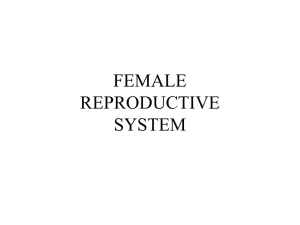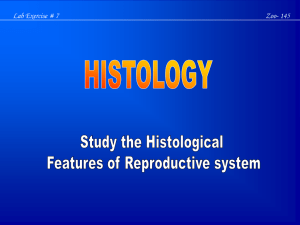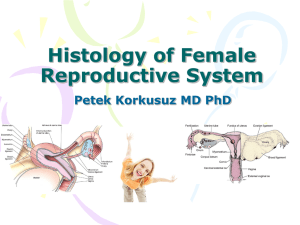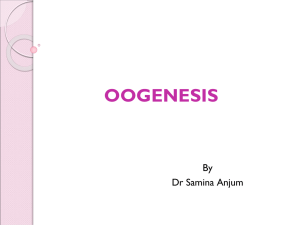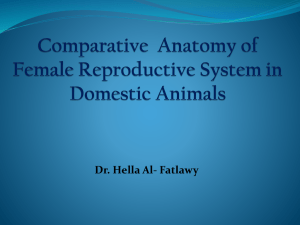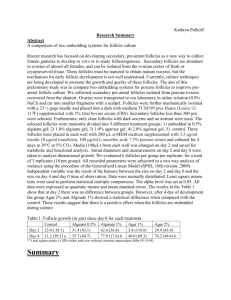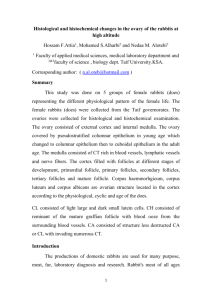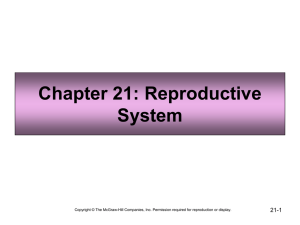Female reproductive system – Copy
advertisement
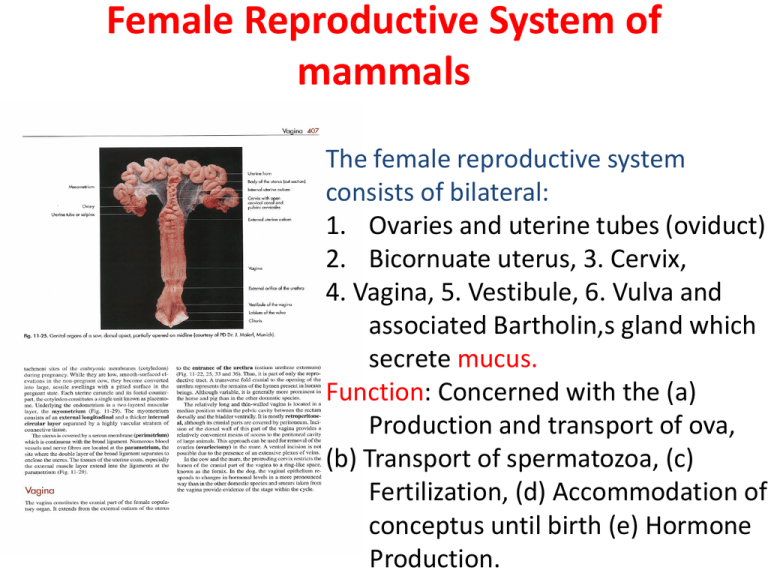
Female Reproductive System of mammals The female reproductive system consists of bilateral: 1. Ovaries and uterine tubes (oviduct) 2. Bicornuate uterus, 3. Cervix, 4. Vagina, 5. Vestibule, 6. Vulva and associated Bartholin,s gland which secrete mucus. Function: Concerned with the (a) Production and transport of ova, (b) Transport of spermatozoa, (c) Fertilization, (d) Accommodation of conceptus until birth (e) Hormone Production. Avian Reproductive System (Oviduct) Two oviducts at birth, however, the left one become functional at maturity. Different parts are: 1. Ovary, 2. Infundibulum, 3. Magnum 4. Isthmus, 5. Uterus, 6. Vagina, 7. Cloaca. Function: Ovary: Production of ova. Infundibulum: Picking of Ova and transport it to the magnum. Magnum: Secretion of albumin Isthmus: Form shell membrane Uterus: Form hard shell Vagina: Expelled mature eggs to exterior Cloaca: common opening for digestive, urinary and reproductive tract. Histology of Ovary The ovary is a combined exocrine and endocrine gland, it produces both ova (exocrine function) and estrogen and progesterone hormone (endocrine function). The structure of the ovary varies with the species of animals, age, and sexual cycle. In general it is ovoid in shape and surrounded by connective tissue layer known as tunica albuginea. The ovary is divided into outer cortex and inner medulla. The cortex is a broad peripheral zone containing follicles, corpora lutea, and interstitial endocrine cells (bitch). whereas, medulla contains connective tissue, blood vessels and lymph vessels and “Retia Ovarii”. Retia Ovarii Retia Ovarii are network of irregular channels lined by cuboidal epithelium and located in the medulla of the ovary of ruminants and carnivors. •Function: The retia ovarii may differentiate into follicular cells when in juxtaposition (opposite position) to the oocyte. Follicles of the Ovary (in the cortex) • When immature or mature ooctyes surrounded by single/many layers of ovarian cells then the structure designated as “follicles”. Follicles are located in the cortex of the ovary. The follicles may be: 1. Primordial follicles. 2. Primary follicles. 3. Secondary follicles 4. Tertiary follicles or graafian follicles 5. Atretic follicles Other structure of the cortex includes: Corpus albicans, corpus luteum, Intertitial endocrine cells, blood vessels, lymph vessels and connective tissue cells. Primordial, Primary, and Atretic Follicles Primordial Follicles: Atretic follicles Primordial Follicles Primary Follicles These follicles are composed of primary oocyte surrounded by simple squamous epithelium. Primordial follicles arise prenatally by mitotic proliferation of internal epithelial cell masses of the ovarian cortex. Primordial follicles are evenly distributed in the ruminant and sow; in the form of clusters in carnivors. Primary Follicles: Primary follicles are composed of primary oocyte surrounded by a simple cuboidal or simple columnar epithelium. The primary oocytes begins its first meiotic division before birth, but the completion of prophase does not occur until the time of ovulation. Millions of potential oocytes present at birth in a single ovary. Most of them regress and only few hundred ovulate during a normal lifetime. Atretic Follicles: Because of few percentage of oocytes ovulate most of the oocytes of the ovary undergo degeneration and glassy appearance. This structure is called atretic follicles. In primordial and primary follicles oocyte first undergo degeneration, in advance stages reverse. Secondary Follicles • The secondary follicles composed of a primary oocyte surrounded by many layer of follicular cells known as granulosa cells. These granulosa cells cells originates from the proliferation of the follicular cells of the primary follicles. • The secondary follicles are also marked by a glycoprotein layer (zona pellucida) around the oocytes. These zona pellucida is secreted by the oocyte itself or by the granulosa cells itself. • As development proceeds , small fluid cleft (future antrum) is formed with the granulosa cells, and a layer of spindle shaped cells, the theca cells formed around the granulosa cells. • In sow and bitch ovary a secondary follicle may contain many oocytes, known as polyovular follicles. Tertiary Follicles/Mature Follicles/Graafian Follicles Mature follicles composed of primary oocyte Antrum or secondary oocyte (oocyte immediately before ovulation) surrounded by many layer of follicular cells. Following layer of cells are observed from the oocyte: 1. Corona radiata: immediately around the zona pullucida. 2. Cumulus oophorus: 2nd layer of cells. 3. Stratum granulosum: Just after the cumulus cells. Granulosa cells secrete fluid of the antrum. 4. Theca interna: Spindle-shaped cells around the granulosa cells. 5. Theca externa: The outer most cell layer of loose connective tissue with fibroblast arranged concentrically around the theca interna. Ovulation Ovary of cow Stigma Release of mature oocyte from the ovary to the fallopian tube by chemical, mechanical, and hormonal means is called ovulation. Process of ovulation: When the mature follicle fully developed it protrudes from the ovary. This condition is called stigma. Increase secretion of liquor folliculi cause swelling of the follicle. Follicular wall become thin Rupture of the follicle. Release of oocytes along with corona radiata into the peritoneal cavity. Corpus hemorrhagicum, Corpus luteum, and Corpus albicans Corpus hemorrhagicum: During ovulation blood vessels ruptured which cause bleeding inside the follicle, and the follicle looks like red mass, hence known as corpus hemorrhagicum. CorpusCorpus luteum: The granulosa cell and theca luteum interna cell enlarge and hypertrophied, accumulate yellow pigment (lutein). The mass now become yellow. This mass is called corpus luteum. Corpus albicans: After the regression of corpus luteum the mass is replaced by white tissue. Size of mature follicle and corpus luteum Size of mature follicle: Cow- 15-20mm Mare- 50-70mm Goat, sow and ewe: 10mm Bitch-2mm Size of corpus luteum: Corpus luteum is fully developed in cow after 9-12 days of ovulation and attains a diameter of about 25mm. Function of Ovary • Production of oocytes. • Secretes estrogen by granulosa cells, and progesterone by the corpus luteum. Uterine Tube /Oviduct/Fallopian Tube • The uterine tubes are bilateral, tortuous structures from the region of the ovary to the uterine horns. Uterine tubes convey ova, spermatozoa and zygotes. Three segments of the uterine tube can be distinguish: 1. Infundibulum: Funnel shaped portion near the ovary. 2. Ampulla: Extending from the infundibulum to the isthmus. 3. Isthmus: Narrow part open into the uterine horn. Image for the Section of Uterine Tube Histology of the Uterine Tube • The epithelium is simple columnar or pseudostratified columnar with motile cilia on the majority of the cells. The epithelia is secretory and non secretory type. The secretory cells become higher during luteal phase. Their secretion provides nutrient to the ovum and zygote. • The mucosa is folded and continous with the submucosa. The ampula is highly folded followed by Infundibulum and isthmus. In the cow, approx. 40 primary and secondary fold. In sow and mare the tube is more folded. In the isthmus there are about 8-10 folds, no secondary folds. Histology of the Uterine Tube • The tunica muscularis chiefly circular smooth muscle fibers. In the infundibulum and isthmus the muscle layer is thin. It is thick in the isthmus. • The tunica serosa consist of connective tissues and contains many blood vessels and nerves. Histology of the Uterus Histology of the Uterus • The uterus is the implantation site of the conceptus. • The mammalian uterus consists of three layer: 1. Endometrium: The inner most layer is the endometrium. The functional zone is a thin layer lined by simple columnar epithelium which slough off during estrus cycle. The subepithelial tissue consists of lymphocytes, monocytes, plasma cells, fibroblasts and other connective tissue cells and fiber. Melanocytes also present here in the sheep. Next to the functional zone is the basal zone. In the endometrium there are numerous simple brached, tubular gland which is lined by psedostratofied columnar epithelium also. Histology of the Uterus • These gland is know as uterine gland which supply nutrient to the embryo. The height of the gland depends on the phase of estrus cycle as well as pregnancy of animals. • In the mare endometrial cups are present in the layer. • In the ruminant thickening of the endometrium called caruncles are present which is rich in fibroblasts and blood supply. Caruncles are the site for the attachment of fetal placenta to maternal placenta. Histology of the Uterus • Myometrium: Consists of thick inner circular and outer longitudinal smooth muscle fiber. Vessels are also rich here. • Perimetrium: Consists of tunica serosa lined by connective tissue fiber with their cells and mesothelium. Cervix of Female Reproductive System Histology of the Cervix Simple columnar Epithelium Epithelium: Simple squamous epithelium. Secretory cells are also present which secrete mucus during estrus and pass through the vagina. During pregnancy it causes mucus plug. In the sow 90% of the lining epithelium is stratified squamous epithelium. The lamina propria is of connective tissue and Tunica muscularis consists of inner circular and outer longitudinal smooth muscles. Histology of the Vagina of Animals The vagina consists of : 1. Lamina epithelia: Stratified squamous epithelium in animals. In cow the cranial part is lined by simple columanar and in sow the whole length of vagina is lined by stratified polyhedral cells. 2. Lamina propria-submucosa is of connective tissue. 3. Tunica muscularis is of 3 layer of smooth muscle. 4. Tunica adventitia is of connective tissue. Avian Oviduct The oviduct of chicken is lined by stratified squamous epithelium in all the segment. The Infundibulum and vagina is aglandular. In the lamina propria of magnum there is an albumin producing gland (pyramidal cells), in the isthmus there is a shell membrane producing gland (Pyramidal cells), and in the uterine lamina propria hard shell producing glands (polyhedral cells)are abundant. Submucosa consists of connective tissue and Tunica muscularis consists of smooth muscles. Oogenesis During embryogenesis At puberty
